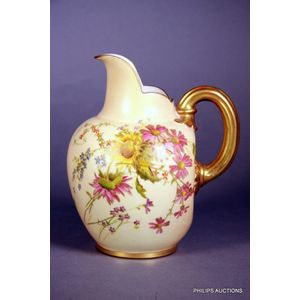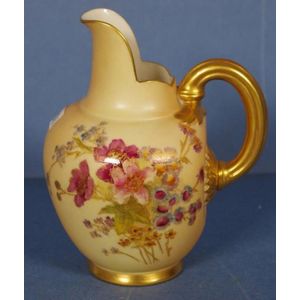Royal Worcester Floral Flatback Jug
You must be a subscriber, and be logged in to view price and dealer details.
Subscribe Now to view actual auction price for this item
When you subscribe, you have the option of setting the currency in which to display prices to $Au, $US, $NZ or Stg.
- Gilding - Gilding is a method of ornamentation whereby a thin sheet of gold metal is applied to items made of wood, leather, ceramics, glass and silver for decorative purposes.
For furniture including mirrors, the sheet of gold is usually applied over a coating of gesso. Gesso is a mixture of plaster of Paris and gypsum mixed with water and then applied to the carved wooden frames of mirrors and picture frames as a base for applying the gold leaf. After numerous coats of gesso have been applied, allowed to dry and then sanded a coat of "bole", a usually red coloured mixture of clay and glue is brushed on and allowed to dry, after which the gold leaf is applied. Over time parts of the gilding will rub off so the base colour can be seen. In water gilding, this was generally a blue colour, while in oil gilding, the under layer was often yellow. In Victorian times, gilders frequently used red as a pigment beneath the gold leaf.
Metal was often gilded by a process known as fire gilding. Gold mixed with mercury was applied and heated, causing the mercury to evaporate, the long-term effect of which was to kill or disable the craftsman or woman from mercury poisoning. The pursuit of beauty has claimed many victims, not the least of which were the artists who made those pieces so highly sought after today. - Flatback - As the name indicates, flatback Staffordshire figures are characterized by their undecorated flat backs and are typically designed to be displayed to sit on a narrow mantlepiece. They often made in pairs and depict popular scenes or characters from literature, mythology, or history, and they were prized for their intricate details and bright colours.
These figures were popular in England during the 19th century, and they were widely produced and sold by a number of different Staffordshire based manufacturers.
In the late 1880's to the early 1900s Royal Worcester also manufactured a series of floral decorated jugs which are termed 'flat backs'. - Foliate - Decorated with leaves or leaf-like forms.
- Ivory - Ivory is a hard white material that comes from the tusks of elephants, mammoth, walrus and boar, or from the teeth of hippopotamus and whales. The ivory from the African elephant is the most prized source of ivory. Although the mammoth is extinct, tusks are still being unearthed in Russia and offered for sale.
Ivory has been used since the earliest times as a material for sculpture of small items, both in Europe and the east, principally China and Japan.
In Asia ivory has been carved for netsuke, seals, okimono, card cases, fan supports, animals and other figures and even as carved tusks.
In the last 200 years in Europe ivory has been used to carve figures, for elaborate tankards, snuff boxes, cane handles, embroidery and sewing accessories, in jewellery and as inlay on furniture. Its more practical uses include being used for billiard balls, buttons, and a veneers on the top of piano keys.
The use and trade of elephant ivory have become controversial because they have contributed to Due to the decline in elephant populations because of the trade in ivory, the Asian elephant was placed on Appendix One of the Convention on International Trade in Endangered Species (CITES), in 1975, and in January 1990, the African elephant was similarly listed. Under Appendix One, international trade in Asian or African elephant ivory between member countries is forbidden. Unlike trade in elephant tusks, trade in mammoth tusks is legal.
Since the invention of plastics, there have been many attempts to create an artificial ivory
This item has been included into following indexes:
-
Royal Worcester (England), item types
- jugs & ewers 335
- other 3,388
Visually similar items

A Royal Worcester flatback jug. 1895, pattern 1094, the globular jug with a ribbed gilded handle and foliate mounts, decorated with floral sprays in muted tones with subtle gilt highlights upon an ivory ground; with puce backstamp and registration number u

A Royal Worcester flatback jug, 1901, pattern 1904, the ovoid jug decorated with sprays of blooms with gilt enrichments upon a blush ivory ground, and having a fluted loop handle with moulded floral mounts in shot gilt colours, green backstamp underside an

A Royal Worcester cream flat back jug, 1888, design 1094. the ovoid jug with a reeded handle and an upright scalloped rim, in a fine cream satin glaze with an Aesthetic movement arrangement of chrysanthemum flowers in various shades of gold; with puce back

Royal Worcester blush ivory porcelain jug, height 13.5 cm
